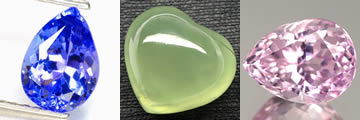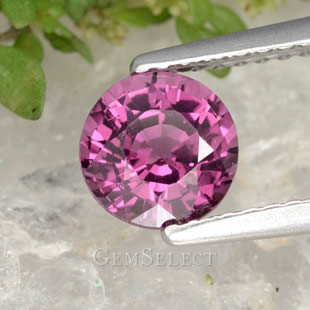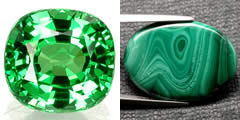|
Reviewed By Andreas Zabczyk
Origin of Gemstone Names
Tanzanite, Prehnite and Kunzite
What's in a name? When it comes to gemstones, sometimes it's a long story. While the names of some of the best known jewels, such as diamonds, are lost in antiquity, many gem quality minerals were not identified until relatively recently, with the advent of the science of gemology. When a new variety is found, the name of the new material can be derived from several sources. The names of many stones come from a Greek or Latin root which refers to a particular trait of the gem. For example, the banded green stone known as malachite got its name from the Greek word for mallow, a green herb, while kyanite is derived from the Greek word kyanos, meaning blue. The name for the pink stone rhodolite is derived from the Greek word for rose-like, as are many other pink minerals such as rhodochrosite and rhodonite. 
Round Rhodolite Garnet Gemstone
It is also common to assign gem names according to the place where they were first found. Tanzanite was discovered in the Tanzanian bushland in 1967, while tsavorite takes its name from Tsavo National Park near the Tanzanian border with Kenya, where in the late 1960s, the geologist Campbell Bridges came across some rocks containing green grossularite, a rare variety of garnet. Similarly andalusite, a beautiful pleochroic gem that appears to be a different color depending upon the direction from which it is viewed, is named after the site of original production in Andalusia, Spain. 
Tsavorite and Malachite
Another common method is to name a gem after its discoverer. Thus prehnite was named after Colonel Hendrik von Prehn and hiddenite was named after W.E. Hidden, who discovered this stone in 1879 in North Carolina (and is also credited with the discovery of rhodolite garnet). Sometimes the person who first identifies a new material has their name immortalized. Although zoisite was first known as saualpite, after its place of discovery in the Saualpe Mountains in 1805, it was renamed after the Slovenian scientist, Baron Sigmund Zois von Edelstein, who realized that it was an unknown mineral when it was brought to him for identification. 
Andalusite and Hiddenite
In yet other cases, a new mineral is named in honor of someone important. The naming of the rare gemstone alexandrite is such a case of historical interest; it was named after Russian Tsar, Alexander II, because the first crystals were discovered in an emerald mine the Ural mountains in April 1834, on the very day this tsar came of age. Alexandrite was later declared to be the national stone of tsarist Russia. Occasionally there is a dispute when attempts to name a new gem are in conflict. Kunzite, the pink variety of spodumene, was named in honor of Dr George Frederick Kunz, of Tiffany & Co., the leading gem expert of his time. However, this gem might have easily ended up with one of several other suggested names instead. Contenders for the honor included no fewer than four would-be discoverers as well as two eminent scientists who identified the substance. This Page in Other Languages
|
| STAY IN TOUCH | NEWSLETTER |
| *You're signing up to receive GemSelect promotional email. |
Copyright © 2005-2024 GemSelect.com all rights reserved.
Reproduction (text or graphics) without the express written consent of GemSelect.com (SETT Company Ltd.) is strictly prohibited.
530